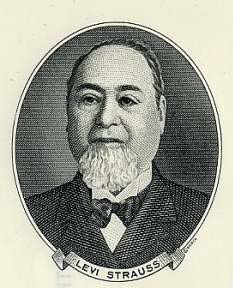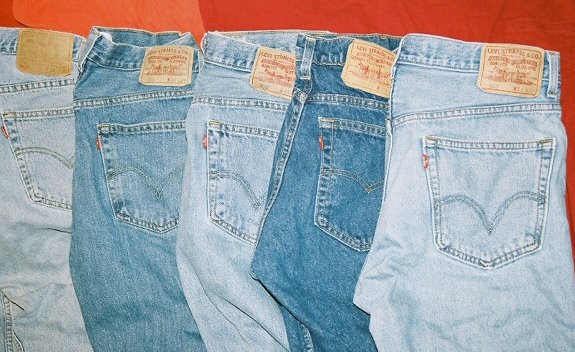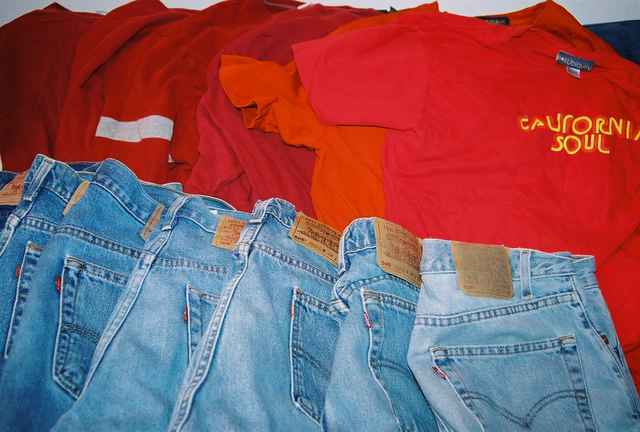| www.FlowBlueJeans.com | www.FlowResearch.com |
welcome to Levi's by the Numbers
|
Levi's By the Numbers (Men's) |
|||
|
This page gives
the different characteristics of different numbered Levi's jeans.
|
|||
|
Levi's 501® Original Jeans - Button Fly - Straight Thru Thigh, Seat, and Leg - 11.5 - 14 Ounces |
|||
| Original 501® Jeans | Shrink-to-Fit | Lightning Blue | |
| Super Destructed Light | Acid Trip | Painted and Repaired | Cracked Dark |
|
Levi's 505® Regular Fit Jeans - Zipper Fly - Sits on the Waist - Rise 11 1/4 inches Straight Thru Thigh, Seat, and Leg - 11.9 - 12.5 Ounces |
|||
| Indie Blue | Tumbled Rigid | Medium Stonewash | Dark Stonewash |
|
Levi's 507® Slim Boot Jeans - Zipper Fly - Sits Below the Waist - Rise 9 1/2 inches 10.75 - 13 Ounces (Depending on Fabric) |
|||
| Sun Soaked | Watered Dark | Worked Blue | Black Diamond |
|
Levi's 511™ Skinny Straight Jeans - Zipper Fly - Sits Below the Waist - Rise 9 5/8 Inches Cut Low at the Waist - Extra Slim Fit - Skinny Leg - 9.25 - 14.5 Ounces |
|||
| Clean Worn | Black Stretch | Eco Blue Flame | |
| Sharkie | Polished Gray | White Cloud | |
|
Levi's 514™ Slim Straight Jeans - Zipper Fly - Sits Below the Waist - Rise 9 5/8 Inches Cut Low at the Waist - 10 - 12.5 Ounces (Depending on Fabric) |
|||
| Overhaul | Black Diamond | Wave | |
| Sunset | Coast | Destructed Light | |
|
Levi's 527™ Low Boot Cut Jeans - Zipper Fly - Sits Below the Waist - Tilts Higher in Back Rise 10 3/8 Inches Straight Fit - Cut Loose Thru Seat and Thigh - 11.25 - 13.5 Ounces (Depending on Fabric) |
|||
| Fade Out | Eco Shadow | Hornet | |
| Indigo Scraped | Pike | ||
|
Levi's 539™ Vintage Straight Jeans - Button Fly - Sits Below the Waist - Rise 10 1/2 Inches Eased Straight Leg and Close-Cut Seat - Relaxed Fit - 10.75 - 14.5 Ounces (Depending on Fabric) |
|||
| Surf | Soft Tumbled | Indigo Wash | |
| Indigo Scraped | Eco Shadow | ||
|
Levi's 550 Relaxed Fit Jeans - Zipper Fly - Sits on the Waist - Rise 11 3/8 inches Tapered Leg - 13.75 -14.5 Ounces |
|||
| Medium Stonewash | Indigo | Dark Stonewash | |
|
Levi's 559™ Relaxed Straight Jeans - Zipper Fly - Sits Below the Waist - Rise 11 inches - Relaxed Fit Straight Leg - 11.9 - 12.5 Ounces |
|||
| Tumbled Rigid | Textured Worn | Indie Blue | |
|
Levi's 560™ Relaxed Fit Jeans - Zipper Fly - Sits on the Waist - Rise 11 1/2 inches - Loose Fit Tapered Leg - 13.75 Ounces |
|||
| Medium Stonewash | Dark Stonewash | ||
|
Levi's {Capital Eye}® Hesher Straight Jeans - Sits Below the Waist - Rise 11 inches |
|||
| Soaked | Aesthetics Bleach | ||
|
Levi's {Capital Eye}® Matchstick Jeans - Sits Below the Waist - Rise 9 7/8 inches - Slim Fit Skinny Leg - 13 Ounces |
|||
| Tokyo Worn | |||
 The
history of jeans goes back to the 15th century.
Jeans fabric was created in Chieri, a town
near Turin in Italy. It was
sold in the harbor of Genoa. The
first jeans were made for the sailors in the Genoese Navy.
These sailors wanted all-purpose pants that could be worn wet or dry,
with legs that could be rolled up while the deck was being swabbed.
These jeans were dragged in nets at the back of the ship for
laundering. The sea water
bleached them white. One likely
origin for the term ‘blue jeans’ is ‘blue de Genes,’ i.e. blue of
Genoa. The
history of jeans goes back to the 15th century.
Jeans fabric was created in Chieri, a town
near Turin in Italy. It was
sold in the harbor of Genoa. The
first jeans were made for the sailors in the Genoese Navy.
These sailors wanted all-purpose pants that could be worn wet or dry,
with legs that could be rolled up while the deck was being swabbed.
These jeans were dragged in nets at the back of the ship for
laundering. The sea water
bleached them white. One likely
origin for the term ‘blue jeans’ is ‘blue de Genes,’ i.e. blue of
Genoa.In
the 16th century, India exported thick cotton cloth named
dungaree. This cloth was sold
near Bombay close to the Dongarii Fort.
It was dyed in indigo. Sailors
cut the cloth to suit themselves. It
was Levi Strauss who popularized blue jeans in the United States.
In the 1850s, Strauss came to San Francisco to open a West Coast
branch of his brother in law’s dry goods business, which was based in New
York. Strauss initially made
pants out of a cotton material. Seeking
something more durable, he switched to brown canvas sailcloth.
After he used up his supply of sailcloth, he switched to a sturdier
fabric called serge that was made in Nimes, France.
This fabric was originally called serge de Nimes, but the name was
shortened to denim. In
the early 1870s, one of Levi Strauss’ customers was Jacob Davis, a tailor
from Reno, Nevada. Davis bought
the cloth from Levi Strauss and made it into pants.
One of Davis’s customers kept ripping his pants pockets.
Davis came up with the idea of putting metal rivets in the pants at
the point of strain.
For
almost 20 years, Strauss and Davis were the only ones allowed to make
riveted clothing until the patent entered the public domain.
The two horse design first appeared in 1886.
In 1890, the pants were assigned the number 501.
Once the patent expired, other companies started making these riveted
denim jeans. In 1936, the red
tab attached to the right rear pocket was introduced as a way to identify
Levi’s jeans at a distance. In
the 1940s, jeans were worn by workers, especially in the factories.
Blue jeans became popular in the 1950s as a symbol of protest against
conformity. In the mid-1950s, Donald Freeland of the Great Western
Garment Company introduced the technique of stone-washing denim.
In the 1960s, blue jeans became widely accepted, especially among the
younger generation. Their popularity continued into the 1970s, 1980s, and 1990s,
and it continues today.
|
|||
 Jacob
Davis decided to patent the metal rivets idea.
Jacob
Davis decided to patent the metal rivets idea.